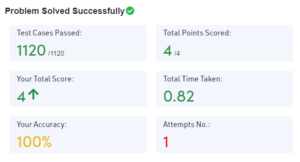Introduction:
Introduce the challenge of finding the largest island in a binary matrix while changing at most one “0” to “1.”
Problem Statement:
- You are given an “n x n” binary matrix where each element is either a “0” or a “1.”
- Your task is to determine the size of the largest island within this matrix after you are allowed to modify at most one “0” to “1.”
- An island consists of a group of connected “1s,” where two “1s” are considered connected if they share a side.
Example Scenarios:
Scenario 1:
Input:
grid = [ [1, 0],
[0, 1]
]
- Output: 3
- Explanation: Change any one “0” to “1,” connecting two “1s,” resulting in an island with an area of 3.
Scenario 2:
Input:
grid = [ [1, 1],
[1, 0]
]
- Output: 4
- Explanation: Change the only “0” to “1” to make the island bigger, resulting in an island with an area of 4.
Scenario 3:
Input:
grid = [ [1, 1],
[1, 1]
]
- Output: 4
- Explanation: In this case, it’s not possible to change any “0” to “1” as there is only one island with an area of 4.
Your Task:
- Your objective is to implement the
largestIsland()function. - This function takes a binary matrix as input and should return an integer representing the size of the largest island in the grid after applying the operation.
How to Approach the Problem:
To solve this problem, we want to find the biggest group of connected “1s” in a grid of “0s” and “1s.” We can make one change, turning a “0” into a “1,” to increase the size of the group. Here’s a simple approach:
- Identify Islands: First, we need to find the islands in the grid. An island is a bunch of “1s” that are next to each other, either horizontally or vertically.
- Count Island Sizes: We count how many “1s” are in each island and remember their sizes. We also give each island a unique ID.
- Find the Biggest Island: We look for the island with the largest size. If there are no “0s” in the grid, then the biggest island is the answer.
- Check Nearby “0s”: If there are “0s” in the grid, we check each “0” and see how big the island would be if we change it to a “1.” To do this, we check how many neighboring islands it would connect to and calculate the new island’s size.
- Return the Largest Size: We compare all the new sizes and the sizes of existing islands to find the largest island size.
By following these steps, we can find the largest island in the grid after making at most one change from “0” to “1.” This approach helps us solve the problem and find the answer we’re looking for.
Answer: This Code was written for Geeks of Geeks Coding Standard so run in Geek of Geeks
from typing import List
class Solution:
def largestIsland(self, grid):
n = len(grid)
def dfs(i, j, island_id):
if i < 0 or i >= n or j < 0 or j >= n or grid[i][j] != 1:
return 0
grid[i][j] = island_id
size = 1
size += dfs(i + 1, j, island_id)
size += dfs(i - 1, j, island_id)
size += dfs(i, j + 1, island_id)
size += dfs(i, j - 1, island_id)
return size
# Create a dictionary to store island sizes
island_sizes = {}
island_id = 2 # Start island IDs from 2 (0 and 1 are reserved for water and land)
for i in range(n):
for j in range(n):
if grid[i][j] == 1:
size = dfs(i, j, island_id)
island_sizes[island_id] = size
island_id += 1
max_area = max(island_sizes.values()) if island_sizes else 0
# Try changing each 0 to 1 and check the new area
for i in range(n):
for j in range(n):
if grid[i][j] == 0:
neighbor_islands = set()
for dx, dy in [(0, 1), (0, -1), (1, 0), (-1, 0)]:
ni, nj = i + dx, j + dy
if 0 <= ni < n and 0 <= nj < n:
neighbor_id = grid[ni][nj]
if neighbor_id != 0: # Skip water
neighbor_islands.add(neighbor_id)
# Calculate the new area if we change this 0 to 1
new_area = 1 + sum(island_sizes.get(island, 0) for island in neighbor_islands)
max_area = max(max_area, new_area)
return max_areaCode Explanation:
1. Finding Islands:
- Imagine the grid is like a map, and we want to discover “islands” within it. An island is a group of “1s” that are next to each other, either horizontally or vertically.
- The code starts in the top-left corner of the grid and moves through each cell. When it encounters a “1” that hasn’t been visited, it labels that “1” and all connected “1s” with a unique number. This way, we know they belong to the same island.
2. Counting Island Sizes:
- We keep track of the size of each island, which means how many “1s” are there in each island. We remember this information in a list or dictionary.
3. Finding the Largest Island:
- We look at all the islands we found and figure out which one is the biggest. The biggest island is our starting point.
4. Checking Nearby “0s”:
- Now, we check if there are any “0s” in the grid. If we find a “0,” we examine the islands that are right next to it (horizontally or vertically).
- We calculate the size of a new island if we turn this “0” into a “1.” To do this, we consider how many “1s” from neighboring islands would join this new island.
5. Returning the Largest Size:
- We compare the sizes of the original islands and the potential new islands we calculated by changing “0s” to “1s.
- Our goal is to find the biggest size among all these options. This is our final answer, which is the size of the largest island we can achieve by making at most one change from “0” to “1.”
Conclusion: Making A Large Island
In this problem, we tackled the challenge of making the largest island possible in a grid of “0s” and “1s.” We used a smart approach to identify islands, count their sizes, and find the biggest one. By changing just one “0” to a “1,” we opened the door to making an even larger island.
The key takeaway is that with a systematic exploration of the grid, we can find the best way to make the largest island. This problem teaches us how to think creatively and use simple tools to solve complex puzzles. In the end, it’s all about Making A Large Island!



